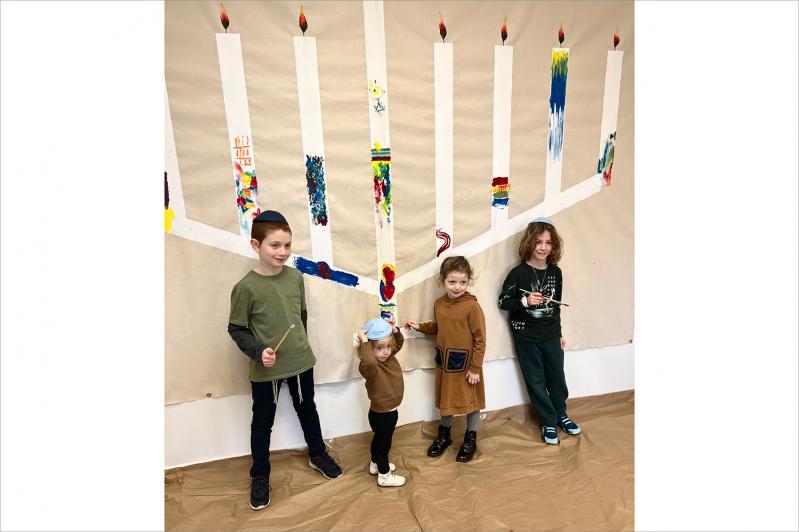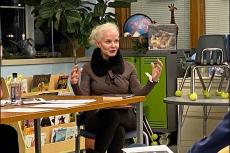It’s 2022, thousands of years since the Israelites triumphed over persecution told in stories from biblical times, and nearly a century after the Holocaust, and we’re still having this conversation. Antisemitism has been amplified lately by celebrities who use social media to perpetuate hateful speech, and hate crimes against Jews are again on the rise.
The East End is not immune to concern. In early November, several swastikas were found carved into benches in the Shelter Island Heights area. About two weeks later, a 21-year-old Aquebogue man wearing a Nazi armband and carrying a large knife was arrested in New York City, charged with making a terrorist threat and other offenses in connection with what law enforcement agencies called “a developing threat to the Jewish community.”
Hate crimes targeting Jews and other minorities led Gov. Kathy Hochul to create a new Hate and Bias Prevention Unit under the authority of the state’s Division of Human Rights. “New York State will use every tool at its disposal to eliminate hate and bias from our communities,” she declared on Monday. “We will not let the rise in hate incidents that we see happening online, across the country, and across the world, take root here at home.”
On the South Fork, antisemitism is being met head-on with action by religious leaders and lay people alike.
At the Center for Jewish Life in Sag Harbor, just in time for Hanukkah, a project called Unity Menorah is under way to encourage widespread celebration and an understanding of Jewish culture.
Temple Adas Israel, the oldest synagogue on Long Island, has signed on to an Anti-Defamation League regional initiative to fight antisemitism through outreach and education.
At the Jewish Center of the Hamptons in East Hampton, Rabbi Josh Franklin has spoken publicly about renaming antisemitism “Jew hatred,” to clear up any ambiguities about what the word may mean.
He has also spoken about “calling in,” rather than “calling out,” people who use hateful or ignorant language in everyday speech.
“A call-in is basically a calling out, but done with love,” Rabbi Franklin explained during a recent service. “It’s addressing a person whom we would like to hold accountable, without the anger and indignation. It takes but a few simple words to disarm the tension and invite someone into a conversation.”
According to Rabbi Berel Lerman, director of the Center for Jewish Life, the Unity Menorah is made of “collective brushstrokes, both real and virtual, painted onto a huge, 10-foot-wide canvas.” The project, he said, will raise funds to help the center to create a permanent space in Sag Harbor; more details can be found online at UnityMenorah.com.
“In a time of rising antisemitism, we invite the public to fight darkness with light and come together to create a beautiful symbol of light,” Rabbi Lerman said. There is a “fine line,” he added, between addressing antisemitism and amplifying it by citing hateful comments such as those of Kanye West or Kyrie Irving.
Lauren Tepper and Julie Takton Kent, members of Adas Israel, established its antisemitism committee in April 2021. It was during a time of unrest in the Middle East that “translated into anger with Jewish people,” said Ms. Tepper, a part-time resident of the village. “There was a lot going on between the Gaza Strip and Israel. Very quickly, people were upset about what was going on and translated it into ‘It’s the Jews’ fault.’ “
“A lot of people were saying really heinous things online that I would never have seen coming.”
“Our goal, in the beginning, was comforting our community just so people knew we were listening,” she continued. “The beginning was just that — people on Zoom talking about what we’ve been through. That evolved pretty quickly into our wanting to do outreach in our town.”
Ms. Kent, who now lives in Vermont but remains a member of Adas Israel, recalled that the temple’s board agreed immediately and unanimously to sign on, at a cost of $1,000, to the Anti-Defamation League’s program, which offers various resources and access to speakers. “I wish we didn’t have to have this group,” she said, “but I’m happy we have it and can go forward to educate and communicate” with non-Jews, who “might realize we’re not ‘different.’ “
Calling the committee “Social Justice 201,” she said that “we can help people find places to live, sponsor a Ukrainian family, glean from farms . . . and use our forces for good, and to take care of ourselves. There are people who really think that we’re evil.”
A look through the archives of this newspaper gives a glimpse into what Jews here have experienced over the years.
In January 1990, an East Hampton shopowner was the target of antisemitic slurs after failing to remove an indelicate poster from his store window during the village’s Christmas parade. That October, The Star received an anonymous letter saying among other things that Jews “have polluted this whole area.” It was not published on the Letters page. Instead, Helen S. Rattray, then the paper’s editor, addressed it in her “Connections” column, saying, “I think it is very important that as many of us as possible be aware of the hatred it expresses, from someone right here in this beautiful place we call home.”
Years before, in May 1984, Dan Rattiner, publisher of Dan’s Papers, had received a threatening handwritten letter with a Hicksville postmark and “a string of antisemitic invective,” The Star reported. In November of that year, the Jewish Center of the Hamptons was the target of a bomb threat — and these are just a few examples.
Today, the center, like many temples and synagogues on Long Island and all across the nation, spends a lot of money on security.
“We don’t have doors wide open and unlocked for everybody to come in,” Rabbi Franklin said. “We’ve had to dedicate significant resources in ways that other faith communities don’t even give thought to. For many Jewish communities, it has become a significant financial strain. We dedicate more resources than we should have to, and we think about it more than we should.”
Rabbi Franklin recommended two books that address the subject in forthright terms: “Fighting Antisemitism” by Bari Weiss and “Antisemitism: Here and Now” by Deborah Lipstadt.
From the Conservative Synagogue of the Hamptons in Bridgehampton, Rabbi Jan Uhrbach also weighed in. “I think the question is, what are non-Jewish organizations doing about it?” she said. “Our members understand it quite well. We’re very aware of what it is and its dangers — I don’t think my community needs me to explain it.”
Building strong relationships with other religious organizations is key to “helping non-Jews to understand what antisemitism is and how serious and dangerous it is,” Rabbi Uhrbach said. Echoing Rabbi Franklin’s point about “calling in,” she added that “we need to say certain things aren’t acceptable — not necessarily by censorship, but by responding and rejecting those viewpoints, and not amplifying them. Not giving positions of power to people who promulgate them.”
“My own feeling is that the Jewish community is quite aware, and that’s not where the work needs to be done primarily.”




